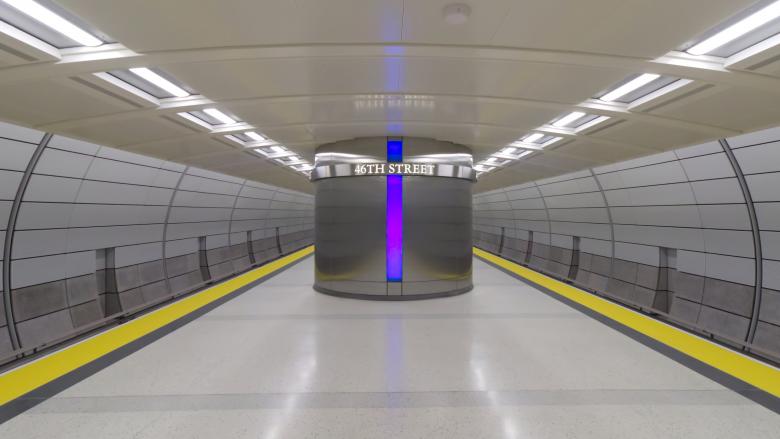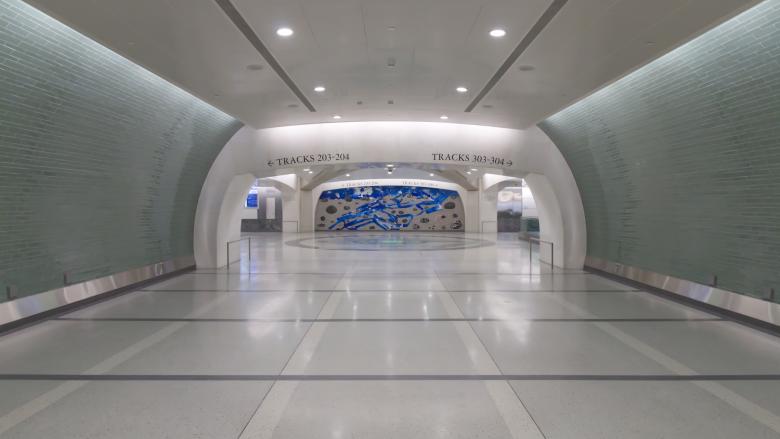Grand Central Madison Opens
Decades in the making, and with a final price tag of $11 billion, the East Side Access project opened on January 25, delivering riders from Long Island to the new Grand Central Madison terminal in East Midtown, Manhattan.
Before yesterday's opening, riders of the Long Island Rail Road (LIRR) had one choice to and from Manhattan: Penn Station, the overtaxed and unloved warren of underground tracks, tunnels, and confusing network of walkways at 34th Street and Seventh Avenue. Riders working near Grand Central Terminal, at Park Avenue and 42nd Street, had to walk or take two short subway rides — roughly 30 minutes in either case — to effectively backtrack one mile north and east across the largest business district in the United States.
That changed at 10:43am yesterday, when a train carrying New York Governor Kathy Hochul, Janno Lieber, the CEO of the Metropolitan Transportation Authority (MTA), and other VIPs left from Jamaica, Queens, and arrived 22 minutes later at Grand Central Madison — so named because it literally sits beneath the century-old Grand Central Terminal and is accessed via a new concourse paralleling nearby Madison Avenue. World-Architects was also on the train, riding it less for the experience (though I was impressed by the unexpectedly smooth ride in the tunnel) and more as a means of getting to the new station to see how its design fares.
Grand Central Madison follows two substantial capital projects of the MTA: the extension of the 7 Train to 34th Street–Hudson Yards, completed in 2015, and the three stations of the new Second Avenue Subway that opened in early 2017. Similar to the Second Avenue Subway, which started construction at the beginning of the 1970s but then was shelved for decades following the city's fiscal crisis that hit in 1975, a bi-level tunnel beneath the East River, the bottom of which would eventually bring LIRR riders to Grand Central, started back in 1969; only the top would open two decades later, in 1989, for the subway's F Train.
It would take another decade for federal money to come in and enable construction to resume on the East Side Access project in 2001. But instead of the hoped-for opening of 2009, the tunnel extensions in Queens and Manhattan, the new ventilation buildings in Midtown, the platforms beneath Grand Central Terminal…all the numerous parts of this complex infrastructural project would take more than twenty years to complete. (Readers who want a clear explanation of the project's complex engineering and logistics should watch this New York Transit Museum presentation from last year.)
Like the Hudson Yards and Second Avenue stations, Grand Central Midtown is spacious, bright and clean — for the time being, at least, this being NYC after all. The platforms are wide, to accommodate the thousands of daily commuters the MTA hopes will opt for East Side access over Penn Station. To start, service is limited to trains moving back and forth between Jamaica and Grand Central Midtown, but a full schedule is supposed to be in place in around a month (the capacity at the 8-track terminal is 24 trains per hour at peak). And although the daily population of Midtown is notably higher than even a year ago, many companies still offer hybrid work conditions, meaning the number of commuters is still shy of pre-pandemic levels. As such, an $11 billion project meant to shave 30 minutes off the morning and evening commutes of Long Islanders arrives at a complicated moment, when pre-pandemic normality has returned in many aspects of life but is not pervasive enough to make even a fraction of the exorbitant price tag — nearly $3.5 billion for each new mile of track! — justifiable to many.
The architecture of Grand Central Terminal — its main concourse, mezzanine, platforms, and escalators — does not appear to be the major contributor to the large and escalating costs; durability, brightness, and ease of maintenance appear paramount over architectural innovation, sumptuousness, or similar considerations. Terrazzo floors are found throughout, marble is used selectively at the mezzanine walls, perforated and solid tile panels line the platform walls, and concrete beams are exposed where they are not covered by drop ceilings. The architectural design by AECOM is functional and markedly better than most stations New Yorkers are used to. Nevertheless, the design should do a good job receding into the background when it is filled with commuters and the 25 retail spaces are rented out. The standout design moments are found in the glass tiles lining the nearly 200-foot-long escalators delivering people from the main concourse to the mezzanine level, and the cylindrical openings that mark the intersections between 45th and 48th Streets and help riders orient themselves 140 feet below Park Avenue.
In the months leading up to yesterday's opening, very little attention was directed — rightly so — at the architectural design of the new terminal. Articles about the new artworks that are part of the MTA Arts & Design program were in abundance, highlighting the contributions by Yayoi Kusama, Kiki Smith, Paul Pfieffer, and other artists. In some cases, as in the mezzanine photograph above, the architecture appears to serve as a frame for the artworks. In other places, like the glass mosaic seen below, the art enlivens walkways that may seem interminable otherwise. Like most MTA stations, Grand Central Madison is not a work of art in and of itself, but it is a great place to see some — and all for free.





